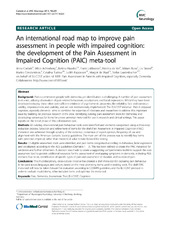An international road map to improve pain assessment in people with impaired cognition: the development of the Pain Assessment in Impaired Cognition (PAIC) meta-tool
Corbett, Anne; Achterberg, Wilco; Husebø, Bettina; Lobbezoo, Frank; de Vet, Henrica; Kunz, Miriam; Strand, Liv Inger; Constantinou, Marios; Tudose, Catalina; Kappesser, Judith; de Waal, Margot; Lautenbacher, Stefan
Peer reviewed, Journal article
Published version
Permanent lenke
https://hdl.handle.net/1956/10198Utgivelsesdato
2014-12-10Metadata
Vis full innførselSamlinger
Originalversjon
https://doi.org/10.1186/s12883-014-0229-5Sammendrag
Background: Pain is common in people with dementia, yet identification is challenging. A number of pain assessment tools exist, utilizing observation of pain-related behaviours, vocalizations and facial expressions. Whilst they have been developed robustly, these often lack sufficient evidence of psychometric properties, like reliability, face and construct validity, responsiveness and usability, and are not internationally implemented. The EU-COST initiative ? Pain in impaired cognition, especially dementia? aims to combine the expertise of clinicians and researchers to address this important issue by building on previous research in the area, identifying existing pain assessment tools for dementia, and developing consensus for items for a new universal meta-tool for use in research and clinical settings. This paper reports on the initial phase of this collaboration task. Methods: All existing observational pain behaviour tools were identified and elements categorised using a three-step reduction process. Selection and refinement of items for the draft Pain Assessment in Impaired Cognition (PAIC) meta-tool was achieved through scrutiny of the evidence, consensus of expert opinion, frequency of use and alignment with the American Geriatric Society guidelines. The main aim of this process was to identify key items with potential empirical, rather than theoretical value to take forward for testing. Results: 12 eligible assessment tools were identified, and pain items categorised according to behaviour, facial expression and vocalisation according to the AGS guidelines (Domains 1 ? 3). This has been refined to create the PAIC meta-tool for validation and further refinement. A decision was made to create a supporting comprehensive toolkit to support the core assessment tool to provide additional resources for the assessment of overlapping symptoms in dementia, including AGS domains four to six, identification of specific types of pain and assessment of duration and location of pain. Conclusions: This multidisciplinary, cross-cultural initiative has created a draft meta-tool for capturing pain behaviour to be used across languages and culture, based on the most promising items used in existing tools. The draft PAIC meta-tool will now be taken forward for evaluation according to COSMIN guidelines and the EU-COST protocol in order to exclude invalid items, refine included items and optimise the meta-tool.

